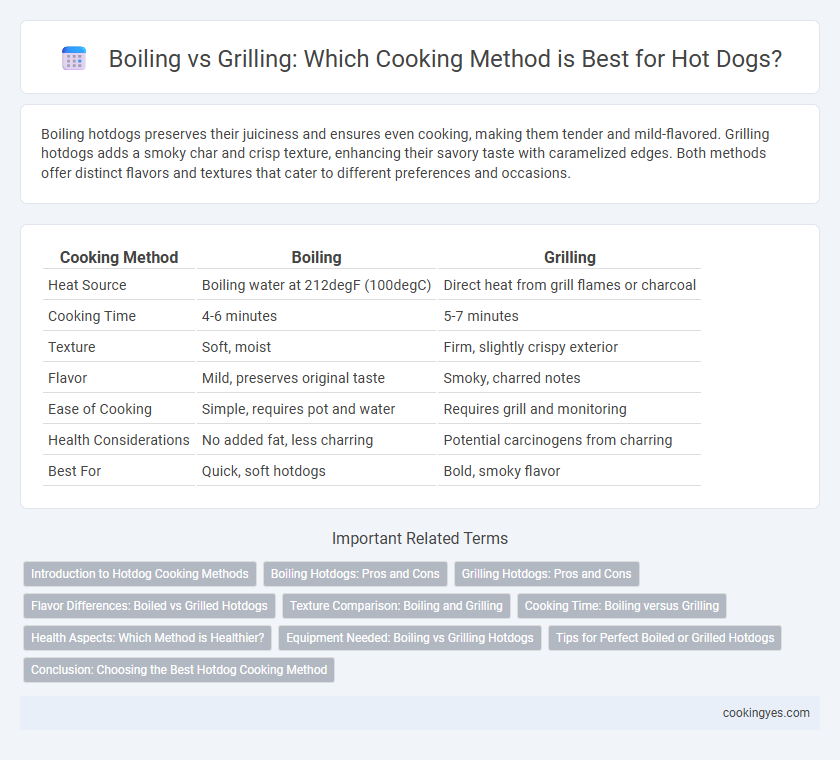Boiling hotdogs preserves their juiciness and ensures even cooking, making them tender and mild-flavored. Grilling hotdogs adds a smoky char and crisp texture, enhancing their savory taste with caramelized edges. Both methods offer distinct flavors and textures that cater to different preferences and occasions.
Table of Comparison
| Cooking Method | Boiling | Grilling |
|---|---|---|
| Heat Source | Boiling water at 212degF (100degC) | Direct heat from grill flames or charcoal |
| Cooking Time | 4-6 minutes | 5-7 minutes |
| Texture | Soft, moist | Firm, slightly crispy exterior |
| Flavor | Mild, preserves original taste | Smoky, charred notes |
| Ease of Cooking | Simple, requires pot and water | Requires grill and monitoring |
| Health Considerations | No added fat, less charring | Potential carcinogens from charring |
| Best For | Quick, soft hotdogs | Bold, smoky flavor |
Introduction to Hotdog Cooking Methods
Boiling hotdogs preserves their juiciness and ensures even cooking, making it a popular method for a tender texture. Grilling enhances flavor through caramelization and imparts a smoky taste with characteristic char marks. Selecting between boiling and grilling depends on desired texture and flavor profile for the hotdog experience.
Boiling Hotdogs: Pros and Cons
Boiling hotdogs ensures even cooking and retains moisture, resulting in a juicy bite without charring. This method is quick and ideal for preparing multiple hotdogs simultaneously, though it can dilute flavors and produce a less crispy texture compared to grilling. Boiled hotdogs remain tender but lack the smoky aroma and grill marks that enhance overall taste perception.
Grilling Hotdogs: Pros and Cons
Grilling hotdogs enhances flavor through caramelization and imparts a smoky aroma that boiling cannot achieve, making them more appealing to many eaters. The high heat of grilling creates a crispy exterior, adding texture contrast to the juicy interior, but it also risks uneven cooking or charring if not monitored closely. While grilling requires more attention and time than boiling, it offers a richer taste experience that is ideal for outdoor barbecues and gatherings.
Flavor Differences: Boiled vs Grilled Hotdogs
Boiling hotdogs results in a tender texture with a mild, juicy flavor, preserving the natural taste of the meat without added char or smokiness. Grilling imparts a distinct smoky aroma and crispy exterior, enhancing the hotdog with caramelized grill marks and a richer, more robust flavor profile. Flavor enthusiasts often prefer grilled hotdogs for their complex taste, while boiling is favored for retaining simplicity and moisture.
Texture Comparison: Boiling and Grilling
Boiling hotdogs results in a soft, juicy texture as the water heat evenly penetrates the meat, preserving moisture throughout. Grilling creates a firmer exterior with a slight crispness and smoky char, adding complex flavors and a satisfying bite. Texture preference depends on whether one favors tender succulence or a robust, slightly crunchy experience.
Cooking Time: Boiling versus Grilling
Boiling hotdogs typically takes about 5 to 7 minutes, providing even heating and maintaining juiciness. Grilling requires around 7 to 10 minutes, offering a smoky flavor and charred texture while needing careful attention to avoid burning. Each method balances cooking time with taste and texture preferences for the perfect hotdog experience.
Health Aspects: Which Method is Healthier?
Boiling hotdogs preserves more nutrients and results in lower formation of harmful compounds compared to grilling, which can produce carcinogenic substances like heterocyclic amines (HCAs) and polycyclic aromatic hydrocarbons (PAHs) due to direct exposure to high heat and smoke. Boiling also avoids added fats commonly used in grilling, reducing calorie intake and promoting cardiovascular health. For a healthier hotdog preparation, boiling is the preferred cooking method as it minimizes potential health risks associated with grilled meat consumption.
Equipment Needed: Boiling vs Grilling Hotdogs
Boiling hotdogs requires minimal equipment, typically just a pot or saucepan filled with water and a heat source, making it a convenient option for indoor cooking. Grilling hotdogs demands a grill or grill pan, along with charcoal or gas for fuel, which imparts a smoky flavor and crispy texture but involves more preparation and cleanup. Choosing between boiling and grilling largely depends on available equipment and desired flavor profile.
Tips for Perfect Boiled or Grilled Hotdogs
For perfectly boiled hotdogs, bring water to a gentle simmer and cook for 5-7 minutes to maintain juiciness without splitting the skin. When grilling, preheat the grill to medium-high heat and turn the hotdogs frequently for even charring and a smoky flavor. Using a fork to poke a few holes in the hotdog before boiling or grilling helps prevent bursting and ensures heat penetrates evenly.
Conclusion: Choosing the Best Hotdog Cooking Method
Boiling preserves moisture and tenderizes hotdogs, making it ideal for soft texture lovers, while grilling imparts a smoky flavor and crisp exterior preferred by those seeking a charred bite. Nutritionally, grilling reduces some fat content as drippings escape, but boiling retains more juices and subtle taste. Selecting the best cooking method depends on personal preference for texture and flavor, with grilling favored for bold taste and boiling for simplicity and moisture retention.
Boiling vs Grilling for hotdog cooking method Infographic

 cookingyes.com
cookingyes.com